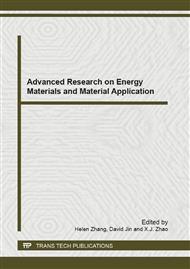[1]
D.J. Finney: Statistical Method in Biological Assay, 2nd edn. Griffin, London(1971).
Google Scholar
[2]
J.H. Lü and S.H. Wu: Bioactivity of essential oil from Ailanthus altissima bark against 4 major stored-grain insects. African Journal of Microbiology Research,Vol. 4:154-157(2010).
Google Scholar
[3]
J.H. Lü and Y. Shi: A laboratory assessment on the effect of powder from Ailanthus altissima, Alpinia officinarum and Cnidium monnieri against Oryzaephilus surinamensis. African Journal of Agricultural Research, Vol. 7: 1331~1334(2012).
Google Scholar
[4]
J.H. Lü and Y. Q He: Fumigant toxicity of Ailanthus altissima Swingle, Atractylodes lancea (Thunb. ) DC. and Elsholtzia stauntonii Benth extracts on three major stored-grain insects. Industrial Crops and Products, Vol. 32: 681–683(2010).
DOI: 10.1016/j.indcrop.2010.06.006
Google Scholar
[5]
M.B. Isman: Botanical insecticides, deterrents, and repellents in modern agriculture and an increasingly regulated world. Annu. Rev. Entomol. Vol. 51, 45–66 (2006).
DOI: 10.1146/annurev.ento.51.110104.151146
Google Scholar
[6]
M.B. Isman: Botanical insecticides: for richer, for poorer. Pest Manag. Sci. Vol. 64, 8–11(2008).
DOI: 10.1002/ps.1470
Google Scholar
[7]
P. Kaelina, L. Zauggb, A.M. Albertini and F. Gadani: Activity of Bacillus thuringiensis isolates on Lasioderma serricorne (F. ) (Coleoptera: Anobiidae). J. Stored Prod. Res. Vol. 35, 145–158(1999).
DOI: 10.1016/s0022-474x(98)00040-x
Google Scholar
[8]
R.Z. Yang and C.S. Tang: Plants used for pest control in China: a literature review. Econ. Bot. Vol. 42, 376–406(1988).
DOI: 10.1007/bf02860162
Google Scholar
[9]
S. Kim, C. Park, M.H. Ohh, H.C. Cho and Y.J. Ahn: Contact and fumigant activity of aromatic plant extracts and essential oils against Lasioderma serricorne (Coleoptera: Anobiidae). J. Stored Prod. Res. Vol. 39, 11–19 (2003).
DOI: 10.1016/s0022-474x(02)00013-9
Google Scholar
[10]
SAS Institute: SAS/STAT User's Guide, Version 6. SAS Institute, Cary, North Carolina(1994).
Google Scholar
[11]
W.S. Abbott: A method of computing the effectiveness of an insecticide. J. Econ. Entomol. Vol. 18, 265–267(1925).
Google Scholar
[12]
Z.L. Liu, S.H. Goh and S.H. Ho: Screening of Chinese medicinal herbs for bioactivity against Sitophilus zeamais Motschulsky and Tribolium castaneum (Herbst). J. Stored Prod. Res. Vol. 43, 290–296(2007).
DOI: 10.1016/j.jspr.2006.06.010
Google Scholar


